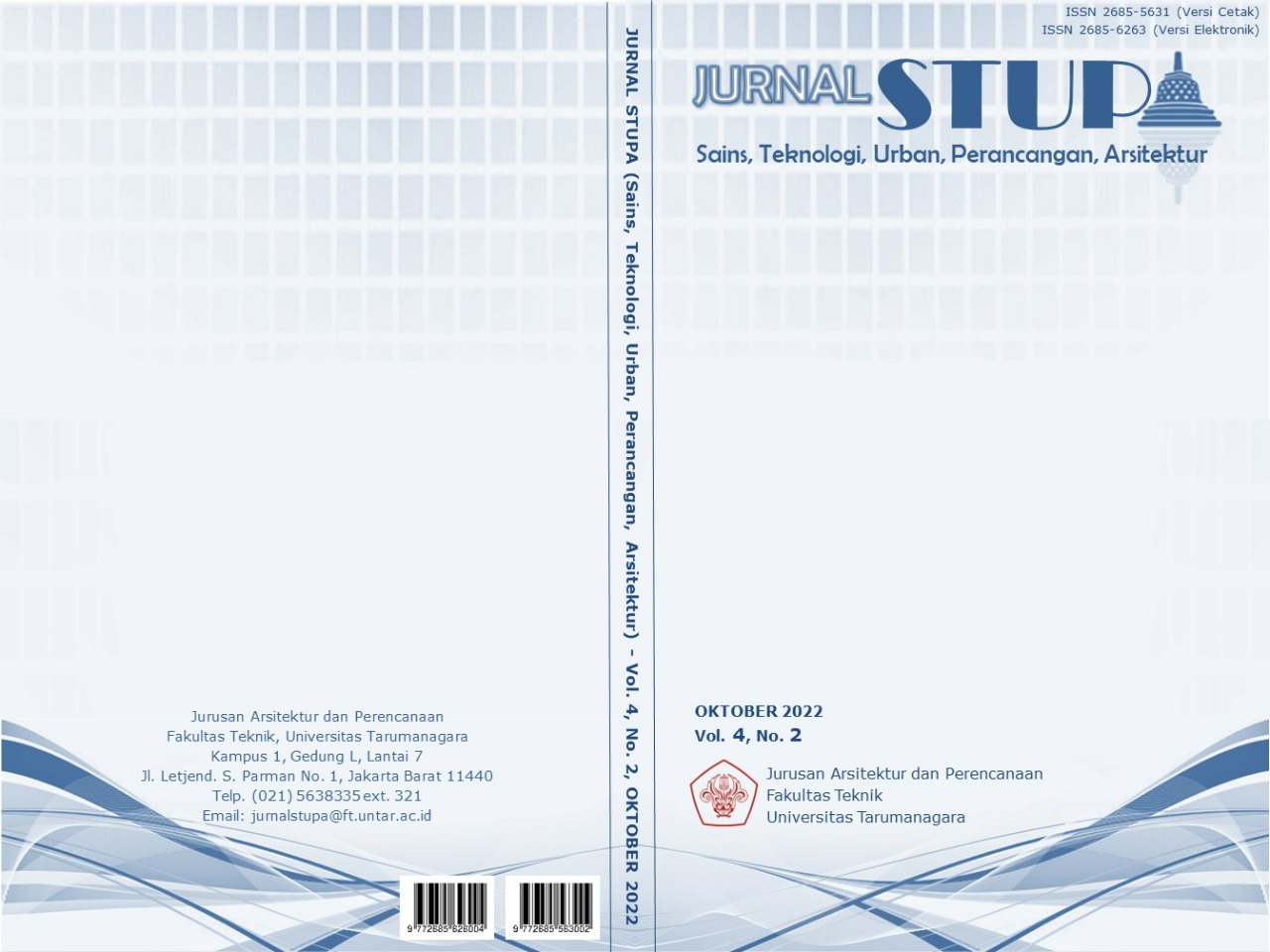ARSITEKTUR HITORISISME DAN KONSERVASI BANGUNAN TATA SASTRA DI KOTA TUA JAKARTA
Main Article Content
Abstract
Kota Tua Jakarta is an area full of history and clear evidence of the founding of the capital city of Jakarta itself. As a city full of stories and developments, it is unsurprising that this area can maintain its originality as many historical buildings still exist. Indeed, more effort is needed as an effort to keep the characteristics and history of the region. Revitalization efforts are a top priority to maintain these assets. In recent years, the government has intensively researched and planned the development of Kota Tua Jakarta in the hope of revitalizing it optimally and thoroughly to prevent knowing a historic city. Revitalization that has not been comprehensive at this time creates new problems, one of which is the availability of land. This also impacts the Kota Tua Jakarta tourist area, where activities at one point create a need for space that is also fun. As a result, several facilities have been provided to support these activities that are not utilized optimally by visitors, one of which is the Taman Kota Intan Parking Area. The research method used is descriptive qualitative research, the Urban Acupuncture approach, and the concept of Transit Oriented Development. The result of the study is an adaptation of the existing land area of Taman Kota Intan Parking and the conservation of class B cultural heritage buildings, Tata Sastra Carbon Paper Factory.
Keywords: Activity; Historicism Architecture; Kota Tua Jakarta; Revitalization; Urban Acupuncture
Abstrak
Kota Tua Jakarta merupakan daerah penuh sejarah dan bukti nyara berdirinya Ibukota Jakarta itu sendiri. Sebagai kota yang penuh dengan cerita dan perkembangan, tidak heran jika kawasan ini mampu mempertahankan orisinalitasnya seperti banyaknya bangunan kolonial bersejarah yang masih berdiri disana. Tentunya diperlukan usaha lebih sebagai upaya dalam mempertahankan ciri khas dan sejarah pada kawasan tersebut. Upaya revitalisasi menjadi prioritas utama sebagai upaya menjaga asset tersebut. Dalam beberapa tahun terakhir, pemerintah gencar meneliti dan juga merencanakan pengembangan Kota Tua dengan harapan mampu melakukan revitalisasi maksimal dan menyeluruh sehingga mampu mencegah hilangnya identitas sebuah kota bersejarah. Revitalisasi yang belum menyeluruh saat ini menimbulkan masalah baru, salah satunya adalah masalah ketersediaan lahan. Hal tersebut turut berdampak pada kawasan wisata Kota Tua Jakarta dimana tingginya aktivitas pada satu titik menciptakan kebutuhan ruang yang juga terpusat. Alhasil terdapat beberapa titik fasilitas yang telah disediakan untuk mendukung aktivtas tersebut kurang dimanfaatkan secara maksimal oleh para pengunjung, salah satunya adalah Lahan Parkir Taman Kota Intan. Metode penelitian yang digunakan adalah dengan metode penelitian deskriptif kualitatif dan juga melalui pendekatan Urban Acupuncture dan konsep Transit Oriented Development. Hasil penelitian merupakan adaptasi lahan eksisting Lahan Parkir Taman Kota Intan dan juga konservasi bangunan cagar budaya golongan B, Pabrik Kertas Karbon Tata Sastra.
Article Details

This work is licensed under a Creative Commons Attribution-NonCommercial-ShareAlike 4.0 International License.
This work is licensed under a Jurnal Sains, Teknologi, Urban, Perancangan, Arsitektur/ STUPA Creative Commons Attribution-NonCommercial-ShareAlike 4.0 International LicenseReferences
Broadbent, G. (1991). Deconstruction: A student guide. Academy Press.
Calthorpe, P. (2011). Urbanism in the age of climate change. Washington, DC.
Casagrande, M. (2010). Urban acupuncture. Retrieved February, 29, 2012.
Colquhoun, A. (1988). Postmodernism and structuralism: A retrospective glance. Assemblage, (5), 7-15.
Danisworo, M., & Martokusumo, W. (2000). Revitalisasi kawasan kota sebuah catatan dalam pengembangan dan pemanfaatan kawasan kota.
Derrida, J. (2020). Deconstruction in a nutshell: A conversation with Jacques Derrida, with a new introduction. Fordham University Press.
Prakosa, W. (2011). Kota Tua Jakarta: Revitalisasi Menyeluruh atau Menghilang?. Proceeding PESAT (Psikologi, Ekonomi, Sastra, Arsitektur &Sipil), 4.
Haryvaldo, K., Sherentya, P., Antoni, V., & Setiawan, C. (2019). PENGEMBANGAN KAWASAN KOTA TUA DAHULU, SEKARANG, DAN YANG AKAN DATANG. Architecture Innovation, 3(1), 86-107.
Hamilton, P. (2004). Historicism. Routledge.
Harris, C. M. (2006). DICTIONARY OF ARCHITECTURE & CONSTRUCTION 4th edition. McGraw-Hill.
Huang, Y. (2019). The Renewal and Reconstruction of Downtown Villages Based on the Perspective of “Urban Acupuncture and Moxibustion”.
Jameson, F. (1991). Postmodernism, or, the cultural logic of late capitalism. Duke university press.
Jenks, C. (1999). Modern movements in architecture. Revista de Arquitectura, Vol. 1 (ene.-mar. 1999); p. 5-6.
Lerner, Jaime. Urban acupuncture. Washington, DC: Island Press, 2014.
Nasional, D. P. (2008). Pusat Bahasa. Kamus Besar Bahasa Indonesia.
Nassar, U. A. E. (2021). Urban acupuncture in large cities: filtering framework to select sensitive urban spots in riyadh for effective urban renewal. Journal of Contemporary Urban Affairs, 5(1), 1-18.
Rachman, M. (2012). Konservasi nilai dan warisan budaya. Indonesian Journal of Conservation, 1(1).
Ratna Yunita. (2010). New Life for Jakarta’s Old Town. Retrieved January 18, 2019, from https://www.itdp.org/2010/03/23/new -life-for-jakartas-old-town/
Saraswati, D. E. (2015). Arahan Revitalisasi Kawasan Cagar Budaya Sebagai Wisata Sejarah Di Kawasan Rajawali Surabaya (Doctoral dissertation, Institut Teknology Sepuluh Nopember).
Siregar, P. (2009). Konservasi sebagai upaya mencegah konflik manusia-satwa. Jurnal Urip Santoso. http://uripsantoso. wordpress. com.
Tschumi, B. (1996). Architecture and disjunction. MIT press.
Utami, N., & Kurniawati, W. (2013). Studi bentuk peran serta masyarakat dalam revitalisasi Pecinan Semarang (Doctoral Dissertation, Universitas Diponegoro).



